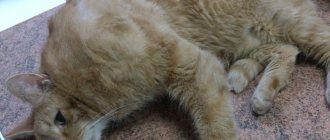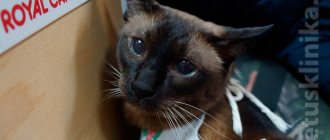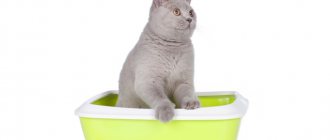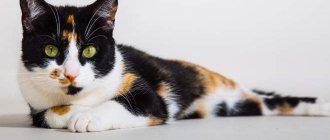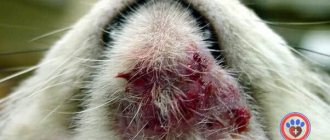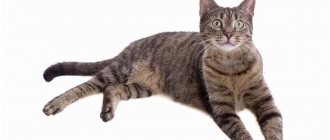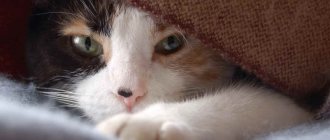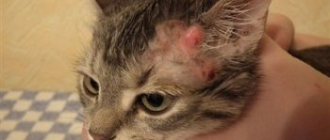Save the article:
Sometimes the owner, showing affection to his furry pet, notices that real dandruff has appeared in the cat’s fur. For many, this will be an unpleasant surprise, especially if the animal’s hygiene is observed according to all the rules. Dandruff in a cat looks the same as in humans - the top layer of skin gradually dies, and the scales flake off from the surface of the skin at a certain speed. Sometimes it happens that an excessive amount of dead cells is formed, then white skin particles appear on the fur, and the pet’s appearance becomes unkempt.
What type of dandruff does cats have?
There are 3 types of dandruff in felines.
- Dry. It can be shaken off your hands and fur. Gives the animal's hair a dry, dull appearance.
- Fat. May have different thickness. Thus, the “liquid” version is manifested by a pronounced greasiness of the hairs, which are glued together. If you stroke the animal, excess secretion will remain on the palm. With increased density of dandruff (less sebaceous secretion and more skin flakes), it remains in large quantities under the owner’s nails when trying to scratch the pet.
- Mixed. The death of skin cells and the work of the sebaceous glands occur unevenly on the surface of the animal’s body, which leads to alternating dry and oily seborrhea.
Medicines
If your pet develops a fungal disease, it is recommended to use special shampoos. One of the most effective is Synergy Labs Veterinary Formula. The product has anti-inflammatory, bactericidal and antifungal effects. The composition of the shampoo is hypoallergenic, so it will not cause an unpredictable reaction in your pet.
The main therapy for the disease is prescribed by a doctor after making a diagnosis and conducting all the necessary research methods. Fungal skin diseases are treated with Amphotericin, Clotrimazole and other drugs. Medicines in the form of ointments are effectively absorbed and lubricate the affected areas of the skin. You can also use tablet forms. Also read the article on how to give a cat a pill.
Cushing's syndrome, caused by a malfunction of the adrenal glands, requires medication, most often Trilostane. If conservative treatment is ineffective, surgical removal of the adrenal glands or pituitary gland is prescribed.
Therapy for hypothyroidism involves replacement therapy with thyroid hormones, as well as dietary adjustments with an increase in foods containing iodine in the menu.
Why does dandruff occur in cats?
The causes of dandruff in cats are divided into two categories: external and internal.
External
Domestic
- Poor coat care (insufficient quality combing, infrequent washing, unsanitary living conditions, etc.)
- Dry air (dry skin leads not only to seborrhea, but also cracking of the pads of the limbs)
- Ultraviolet rays (accelerate keratinization processes, dry the skin, disrupt heat exchange processes)
- Incorrectly selected animal coat care products
- Stress
- Microtrauma of the epidermis (for example, due to an incorrectly selected comb)
- Frequent bathing (leads to dry skin)
- Allergies (to food, bedding material, parasites, etc.)
- Overweight cat
- Errors in the diet
- Deficiency or excess of vitamins or minerals in food
- Disturbances in the activity of the endocrine system (diabetes, hypothyroidism and others)
- Digestive diseases
- Infections (bacterial, fungal)
- Heredity (idiopathic variant of pathology caused by genes)
- Side effect from taking medications (external or internal)
External reasons
External factors include:
- fungus. Due to the activity of fungal microorganisms, excessive exfoliation of the skin occurs;
- burned by the sun's rays. When exposed to the sun, the skin is affected by UV rays, as a result of which the top layer of the skin dries out and dandruff appears;
- poor hygiene. You need to properly care for your cat, but without fanaticism. With insufficient care and excessively frequent bathing with detergents, dandruff may appear;
- parasites. Fleas and ticks infect the skin, disrupt the activity of the sebaceous glands, resulting in excessive exfoliation of the skin;
- ecology. Unsuitable humidity and temperature conditions negatively affect the skin. Dryness and heat lead to flaking, which results in dandruff.
Diagnosis of dandruff in cats
To cure a mustachioed pet, you need to find out why he has dandruff. And here you cannot do without the help of a veterinarian. At the clinic, the owner will definitely be asked about the cat’s living and feeding habits, favorite habits (for example, he prefers to “sunbathe” in direct sunlight), hygiene products, previous diseases, and so on.
A mandatory item will be the passing of laboratory tests (which ones - at the discretion of the doctor):
- blood for general indicators, biochemistry, hormonal changes;
- taking material from the surface of the skin;
- biopsy;
- cultural research in a nutrient medium and others.
If tests show pathological changes in the animal's body, the veterinarian may order further examination.
Is it possible to determine the cause of dandruff at home?
In the absence of a veterinarian, you can roughly find out what caused dandruff in your cat. For example, if there are light yellow scales on the pet’s body, then such seborrhea can be caused by allergies, UV radiation (from the sun), or a disorder of the internal organs.
Photo of dandruff in a cat
Black dandruff is a sign of an infectious disease caused by parasites or fungus. If this symptom occurs, the owner should immediately take the cat to a veterinarian.
If increased shedding of dead skin particles is localized near the tail, it can be assumed that the pet has received a sunburn or has contracted a fungal infection. The same location of seborrhea is observed in felines that are overweight (since it is physically difficult for the animal to reach this area).
Helminth infections, dermatomycosis, joint diseases and other pathologies can lead to dandruff, localized not only in the tail area, but also in the lumbar area. And wandering dandruff (in the form of “tracks”) on the back, face, and paws is often a sign of a subcutaneous mite.
What is dandruff
In cats, it is wrong to talk about dandruff in the usual human understanding. If peeling is observed, then first of all we are talking about hyperkeratosis. The epidermis (the top layer of skin) is constantly renewed. The keratinized (dead) scales peel off from the surface of the skin. This happens unnoticeably to the eye and is natural.
When the keratinization process is too intense, it manifests itself as peeling with white or gray scales and the appearance of growths. You can notice this if you hold it against the growth of the fur in the sacrum area. After which the scales will appear on the surface. And if there are a lot of grains and flakes, then you need to look for the reason.
How to treat dandruff in cats
Treatment of dandruff in cats is carried out comprehensively and necessarily involves compliance with hygiene rules. The owner of a furry pet will have to not only provide it with medications, but also carry out a general cleaning of the room, monitor its behavior so that there is no hypothermia, overheating, contact with foreign animals, and so on.
Therapeutic measures include:
- drug treatment of the underlying disease, if it has been identified;
- taking antihistamines to relieve itching;
- taking vitamins;
- use of medicinal detergents;
- traditional methods;
- diet therapy (especially if you are overweight and have allergic dandruff);
- massage that improves blood circulation in the skin.
If the air is extremely dry, it is recommended to install a humidifier or use improvised methods.
Periodic brushing is one of the measures to prevent dandruff in cats.
Drug treatment
Medicines prescribed for the treatment of dandruff in patients with mustaches may belong to different groups. In case of inflammatory processes on the skin (dermatitis) or their high risk, the doctor will prescribe anti-inflammatory drugs, and in case of itching - antihistamines. Depending on the disease that provoked seborrhea, the following groups of medications may be prescribed:
- anthelmintics;
- antifungal;
- hormonal;
- antibacterial.
If the reason lies not in an internal disorder, but in an external factor, then, as a rule, they limit themselves to diet, folk methods and a change in hygiene products.
Vitamins for dandruff
The veterinary pharmacy today offers a huge selection of vitamin and mineral complexes that help restore the cat’s metabolism and appearance. Some of them are aimed at activating hair growth (Sherstevit), others have an antiallergic effect (for example, Veda). There are complexes that normalize the functioning of the sebaceous glands, affecting metabolic processes in general (Farmavit-neo). Taking vitamins is an essential part of treating dandruff, regardless of its cause.
Medicinal shampoos
Medicated shampoos will help rid your cat of severe dandruff. When choosing, you need to pay attention to the composition. They usually contain the following components.
Component
Action
Chlorhexidine
Antiseptic, antibacterial action.
Salicylic acid
Promotes faster rejection of dead skin particles. Has a healing effect.
Zinc
Has a healing effect. Stimulates the restoration of the epidermis.
Burr oil
It has anti-inflammatory, regenerating, hair growth stimulating effects. Softens the skin.
Plant extracts
They have a variety of therapeutic effects on hair and skin.
The most popular shampoos at the moment are: Fiprex (for external parasites), Doctor (antiseborrheic, destroys fungus), Biovax (normalizes the activity of the sebaceous glands).
Important: the therapeutic hygiene product must match the type of dandruff the cat has. Otherwise, complications may occur.
Traditional methods
Medicinal shampoos have proven themselves against dandruff
When choosing one or another traditional method of treatment, you also need to consider what type of dandruff a cat develops. For example, with dry dandruff, lactic acid, urea, and oils are used to wash the animal. If the scales are oily, drying agents are used: salicylic acid, vinegar, preparations with sulfur. In any case, rubbing oils (burdock, olives, calendula) into the hair and skin gives a good effect, since at the same time the skin is massaged, blood flow is improved, and the epidermis is cleansed.
Wool can be wiped with decoctions of medicinal plants. Often used are infusions of calendula or string, burdock, and oat decoction. Such rubbing can be done every other day. Pouring or bathing in herbal decoctions can be done once every 1-2 months. You can combine washing with a medicated shampoo and rinsing the wool with a herbal solution.
Treatment of seborrhea
Treatment of seborrhea is prescribed comprehensively, it includes:
- prescription of medications;
- changing the diet and composition of food;
- prescription of vitamins (Sherstevit, Phytomins VEDA, Farmavit NEO, Beaphar and others) and food additives containing Omega-3 fatty acids;
- prescribing a course of antifungal therapy and antibiotics for fungal and bacterial infections, as well as retinoids;
- improving the sanitary condition of the room where the cat lives;
- changing the care of the animal's fur;
- use of medicated shampoos;
- use of folk remedies;
- skin massage and proper combing of the coat.
Carefully! At home, treatment of seborrhea can be carried out after consulting a doctor, prescribing special detergents and permission to use traditional medicine.
Effective shampoos for seborrhea include:
- Antifungal and antiseborrheic: “Doctor”, “Veterinary Formula Clinical Care”, “Tea Tree”, SynergyLabs Veterinary Formula Antiseptic & Antifungal, Anju Beauté.
- For fleas and parasites: “Clandestine”, “Bayer Adventage 80”, “Beaphar”, “Fiprex”.
- For ectoparasites: "Lufenuron Oral Suspension For Cats".
- To normalize the functioning of the sebaceous glands: “Biovax”
Such shampoos, in a certain dosage, contain substances that can fight the disease and its consequences, for example:
- chlorhexine (antibacterial effect);
- zinc (skin regeneration and healing);
- salicylic acid (exfoliation of dead epithelial cells, healing of the skin);
- vinegar (fights infections, has an antibacterial effect);
- olive, burdock or calendula oils (promote softening and renewal);
- herbs: string, chamomile, burdock (relieves itching, irritation, restores epithelium).
It is dangerous to practice many of these ingredients on your own to treat seborrhea without consulting your doctor; you need to know the correct dosage, frequency and duration of their use.
Treatment at home
There are traditional medicine remedies and recipes that your doctor will most likely allow you to use to fight the disease at home:
- Bathing the pet once every 2 months with a special shampoo, massaging the skin and combing the skin during the procedure. Actions during and after washing: for dry seborrhea, use moisturizers in the form of oils added to water (urea, propylene glycol, sodium lactate, lactic acid);
- in case of oily seborrhea, in case of severe course and complications of the disease with dermatitis, remove the hair from the pet’s skin, then use bandages with ethyl alcohol for disinfection, treat the skin with Engystol to eliminate inflammation and itching. In addition, for this type of disease, products are used that degrease and dry excessively oily skin (sulfur compounds 0.5-2%, salicylic acid 0.5-2%, selenium sulfide, benzoyl peroxide).
- series;
Why is dandruff dangerous for cats?
Neglected dandruff can lead to complications. One of them is hair loss, up to complete or local baldness. It happens that such places are difficult or impossible to restore in the future. Hair loss occurs due to the fact that dandruff accumulations interfere with gas exchange in the skin, causing disruption of metabolic processes and weakening of hair follicles.
Another complication is purulent inflammation of the skin, reaching the deep layers. The accumulation of dead epidermis serves as an excellent breeding ground for the proliferation of pathogenic microorganisms. Normally, they live on healthy skin, but cannot cause harm due to the good functioning of local immunity. With seborrhea, the immune system weakens, microbes multiply, redness, irritation, and itching occur. As a result of scratching, the infection penetrates even deeper - ulcers, pus, and eczema appear.
Complications of pathology
If a cat develops dandruff, the phenomenon requires urgent treatment. If neglected, it can cause serious complications:
- dermatitis purulent lesions at the site of seborrhea due to bacteria;
- eczema. The animal is constantly itching, the inflamed area turns red, and after scratching, bubbles with liquid appear.
Pets who are bothered by dandruff feel constant itching, suffer from pain, their skin is inflamed, covered with wounds and ulcers.
Signs of dermatitis development
Prevention measures
The appearance of dandruff on your cat's fur can be prevented. To do this you will need:
- Brush your pet periodically, especially if it has long hair, and also during shedding;
- prevent the animal from staying in the sun for a long time;
- provide a balanced diet, sufficient amounts of vitamins and minerals;
- when feeding industrial formulations, carefully read the information about the ingredients they contain, avoiding large amounts of allergenic substances (dyes, preservatives, flavors);
- during water procedures, monitor the water temperature, preventing it from increasing;
- buy quality shampoos;
- regularly carry out prevention of internal and external parasites;
- monitor the caloric content of your cat’s food, avoiding excess weight;
- eliminate stress.
When you notice the first symptoms, you must take your cat to a veterinarian. You should not treat dandruff on your own through trial and error.
Preventive measures
To prevent the appearance of dandruff, the following measures should be taken:
- regular hygiene procedures. The coat should be brushed and combed every day;
- ensuring comfortable environmental conditions. The cat should not be constantly exposed to hot conditions;
- use of specialized shampoos;
- use of anti-parasite agents;
- balanced diet;
- ensuring a normal level of humidity in the room.
Causes of seborrheic dermatitis in adolescents
As mentioned above, the causative agent of dermatitis is a fungus. However, it does not begin to multiply and function too actively without any reason. It becomes overly active only when the balance in the body is disturbed, the reasons for which are the following factors:
- puberty;
- heredity, genetic predisposition;
- disturbances in the functioning of the gonads, adrenal glands, pituitary gland, thyroid gland;
- disruption of the endocrine system, which disrupts the production of sebum;
- severe nervous tension, stressful situations;
- poor nutrition, lack of vitamins, as well as disturbances in the gastrointestinal tract;
- incorrect mode: lack of sleep, lack of walks and physical activity, sedentary lifestyle.
Only a doctor can determine the exact cause of dermatitis, especially if it lies in disturbances in the functioning of internal organs or systems. The doctor will order tests and examinations, make a diagnosis and prescribe treatment. But before visiting a doctor, you can analyze your health status, evaluate your lifestyle and guess the main reason. Often, normalizing your lifestyle allows you, if not to get rid of seborrheic dermatitis, then at least to slightly improve the condition of the skin.
How does scalp fungus manifest itself: the most common symptoms
The cause of itching, flaking (dandruff), and hair loss is very often a fungus (mycosis). The most common areas of the scalp are:
- Microsporum: cause microsporia;
- Trichophyton: are the causative agents of trichophytosis (ringworm);
- Malassezia furfur: leads to seborrhea.
Each infection will manifest itself differently, but some of the most common alarming symptoms can be identified - the simultaneous manifestation of two or more should alert every person:
- sudden deterioration in the general condition of the hair: it became dry, dull, and began to fall out profusely;
- dandruff has appeared (even though this has not been observed before), and/or its amount is increasing;
- separately localized flaky areas appeared;
- bald spots and bald spots form, which quickly grow;
- wounds, crusts, and bumps of unknown origin were found on the scalp;
- the hair becomes brittle at the base of the follicle, resulting in black spots appearing on the skin.
Mycoses do not reveal themselves at an early stage, so you should be very careful and if any symptom appears, immediately contact a specialist. Trichologists or dermatologists deal with problems of the scalp.
What happens if seborrhea in teenagers is not treated?
Often, when skin problems appear during puberty, parents think that they will go away on their own with time. Yes, sometimes that happens. But often teenage seborrhea becomes chronic, from which a person suffers throughout his life.
The consequences of seborrheic dermatitis can be eczematous conditions and severe forms of acne. If seborrheic manifestations are localized on the head, this leads over time to hair loss and even baldness. If the dermatitis affects the area around the ears, it can spread inward and lead to ear infections.

